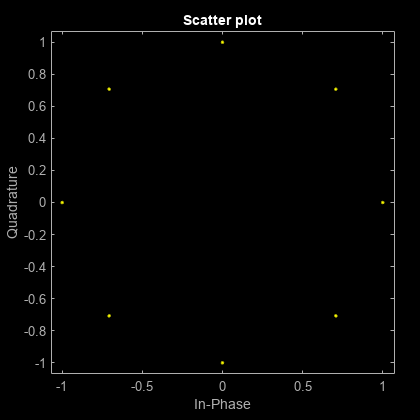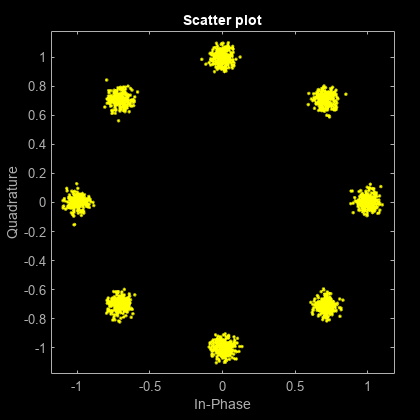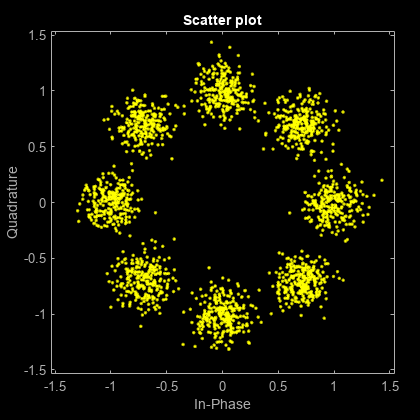comm.AWGNChannel
Add white Gaussian noise to input signal
Description
comm.AWGNChannel adds white Gaussian noise to the input signal.
When applicable, if inputs to the object have a variable number of channels, theEbNo,EsNo,SNR,BitsPerSymbol,SignalPower,SamplesPerSymbol, andVarianceproperties must be scalars.
To add white Gaussian noise to an input signal:
Create the
comm.AWGNChannelobject and set its properties.Call the object with arguments, as if it were a function.
To learn more about how System objects work, seeWhat Are System Objects?
Creation
Description
awgnchan= comm.AWGNChannelawgnchan。This object then adds white Gaussian noise to a real or complex input signal.
awgnchan= comm.AWGNChannel(Name,Value)awgnchan, with the specified propertyNameset to the specifiedValue。You can specify additional name-value pair arguments in any order as (Name1,Value1,...,NameN,ValueN).
Properties
Unless otherwise indicated, properties arenontunable, which means you cannot change their values after calling the object. Objects lock when you call them, and thereleasefunction unlocks them.
If a property istunable, you can change its value at any time.
For more information on changing property values, seeSystem Design in MATLAB Using System Objects。
NoiseMethod—Noise level method
'Signal to noise ratio (Eb/No)'(default) |'Signal to noise ratio (Es/No)'|'Signal to noise ratio (SNR)'|'Variance'
Noise level method, specified as'Signal to noise ratio (Eb/No)','Signal to noise ratio (Es/No)','Signal to noise ratio (SNR)', or'Variance'。For more information, seeSpecifying the Variance Directly or Indirectly。
Data Types:char
EbNo—Ratio of energy per bit to noise power spectral density
10(default) |scalar|row vector
Ratio of energy per bit to noise power spectral density (Eb/No) in decibels, specified as a scalar or 1-by-NCvector.NCis the number of channels.
Tunable:Yes
Dependencies
This property applies whenNoiseMethodis set to'Signal to noise ratio (Eb/No)'。
Data Types:double
EsNo—Ratio of energy per symbol to noise power spectral density
10(default) |scalar|row vector
Ratio of energy per symbol to noise power spectral density (Es/No) in decibels, specified as a scalar or 1-by-NCvector.NCis the number of channels.
Tunable:Yes
Dependencies
This property applies whenNoiseMethodis set to'Signal to noise ratio (Es/No)'。
Data Types:double
SNR—Ratio of signal power to noise power
10(default) |scalar|row vector
Ratio of signal power to noise power in decibels, specified as a scalar or 1-by-NCvector.NCis the number of channels.
Tunable:Yes
Dependencies
This property applies whenNoiseMethodis set to'Signal to noise ratio (SNR)'。
Data Types:double
BitsPerSymbol—Number of bits per symbol
1(default) |positive integer
Number of bits per symbol, specified as a positive integer.
Dependencies
This property applies whenNoiseMethodis set to'Signal to noise ratio (Eb/No)'。
Data Types:double
SignalPower—Input signal power
1(default) |positive scalar|row vector
Input signal power in watts, specified as a positive scalar or 1-by-NCvector.NCis the number of channels. The object assumes a nominal impedance of 1 Ω.
Tunable:Yes
Dependencies
This property applies whenNoiseMethodis set to'Signal to noise ratio (Eb/No)','Signal to noise ratio (Es/No)', or'Signal to noise ratio (SNR)'。
Data Types:double
SamplesPerSymbol—Number of samples per symbol
1(default) |positive integer|row vector
Number of samples per symbol, specified as a positive integer or 1-by-NCvector.NCis the number of channels.
Dependencies
This property applies whenNoiseMethodis set to'Signal to noise ratio (Eb/No)'or'Signal to noise ratio (Es/No)'。
Data Types:double
VarianceSource—Source of noise variance
'Property'(default) |'Input port'
Source of noise variance, specified as'Property'or'Input port'。
Set
VarianceSourceto'Property'to specify the noise variance value using theVarianceproperty.Set
VarianceSourceto'Input port'to specify the noise variance value using an input to the object, when you call it as a function.
For more information, seeSpecifying the Variance Directly or Indirectly。
Dependencies
This property applies whenNoiseMethodis'Variance'。
Data Types:char
Variance—White Gaussian noise variance
1(default) |positive scalar|row vector
White Gaussian noise variance, specified as a positive scalar or 1-by-NCvector.NCis the number of channels.
Tunable:Yes
Dependencies
This property applies whenNoiseMethodis set to'Variance'andVarianceSourceis set to'Property'。
Data Types:double
RandomStream—Source of random number stream
'Global stream'(default) |'mt19937ar with seed'
Source of random number stream, specified as'Global stream'or'mt19937ar with seed'。
When you set
RandomStreamto'Global stream',object uses the MATLAB®default random stream to generate random numbers. To generate reproducible numbers using this object, you can reset the MATLAB default random stream. For examplereset(RandStream.getGlobalStream)。For more information, seeRandStream。When you set
RandomStreamto'mt19937ar with seed',object uses the mt19937ar algorithm for normally distributed random number generation. In this scenario, when you call theresetfunction, the object reinitializes the random number stream to the value of theSeedproperty. You can generate reproducible numbers by resetting the object.
For a complex input signal, the object creates the random data as follows:
N Sis the number of samples andN Cis the number of channels.Dependencies
This property applies whenNoiseMethodis set to'Variance'。
Data Types:char
Seed—Initial seed
67(default) |nonnegative integer
Initial seed of the mt19937ar random number stream, specified as a nonnegative integer. For each call to theresetfunction, the object reinitializes the mt19937ar random number stream to theSeedvalue.
Dependencies
This property applies whenRandomStreamis set to'mt19937ar with seed'。
Data Types:double
Usage
Description
outsignal= awgnchan(insignal,var)'Variance'andVarianceSourceto'Input port'。
For example:
awgnchan = comm.AWGNChannel('NoiseMethod','Variance', ... 'VarianceSource','Input port'); var = 12; ... outsignal = awgnchan(insignal,var);
Input Arguments
insignal—Input signal
scalar|vector|matrix
Input signal, specified as a scalar, anNS-element vector, or anNS-by-NC矩阵。NSis the number of samples andNCis the number of channels.
Data Types:double
Complex Number Support:Yes
var—Variance of additive white Gaussian noise
positive scalar|row vector
Variance of additive white Gaussian noise, specified as a positive scalar or 1-by-NCvector.NCis the number of channels, as determined by the number of columns in the input signal matrix.
Output Arguments
outsignal— Output signal
matrix
Output signal, returned with the same dimensions asinsignal。
Object Functions
To use an object function, specify the System object as the first input argument. For example, to release system resources of a System object namedobj, use this syntax:
release(obj)
Examples
Create Default AWGN Channel System Object
Create an AWGN channel System object with the default configuration. Pass signal data through this channel.
Create an AWGN channel object and signal data.
awgnchan = comm.AWGNChannel; insignal = randi([0 1],100,1);
Send the input signal through the channel.
outsignal = awgnchan(insignal);
Add White Gaussian Noise to 8-PSK Signal
Modulate an 8-PSK signal, add white Gaussian noise, and plot the signal to visualize the effects of the noise.
Create a M-PSK modulator System object™. The default modulation order for the object is 8.
pskModulator = comm.PSKModulator;
Modulate the signal.
modData = pskModulator(randi([0 7],2000,1));
添加高斯白噪声调制信号by passing the signal through an additive white Gaussian noise (AWGN) channel.
channel = comm.AWGNChannel('EbNo',20,'BitsPerSymbol',3);
Transmit the signal through the AWGN channel.
channelOutput = channel(modData);
Plot the noiseless and noisy data by using scatter plots to visualize the effects of the noise.
scatterplot(modData)

scatterplot(channelOutput)

Change theEbNoproperty to 10 dB to increase the noise.
channel.EbNo = 10;
Pass the modulated data through the AWGN channel.
channelOutput = channel(modData);
Plot the channel output. You can see the effects of increased noise.
scatterplot(channelOutput)

Process Signals When Number of Channels Changes
Pass a single-channel and multichannel signal through an AWGN channel System object™.
Create an AWGN channel System object with the Eb/No ratio set for a single channel input. In this case, theEbNoproperty is a scalar.
channel = comm.AWGNChannel('EbNo',15);
Generate random data and apply QPSK modulation.
data = randi([0 3],1000,1); modData = pskmod(data,4,pi/4);
Pass the modulated data through the AWGN channel.
rxSig = channel(modData);
Plot the noisy constellation.
scatterplot(rxSig)

Generate two-channel input data and apply QPSK modulation.
data = randi([0 3],2000,2); modData = pskmod(data,4,pi/4);
Pass the modulated data through the AWGN channel.
rxSig = channel(modData);
Plot the noisy constellations. Each channel is represented as a single column inrxSig。The plots are nearly identical, because the same Eb/No value is applied to both channels.
scatterplot(rxSig(:,1)) title('First Channel')

scatterplot(rxSig(:,2)) title('Second Channel')

Modify the AWGN channel object to apply a different Eb/No value to each channel. To apply different values, set theEbNoproperty to a 1-by-2 vector. When changing the dimension of theEbNoproperty, you must release the AWGN channel object.
release(channel) channel.EbNo = [10 20];
Pass the data through the AWGN channel.
rxSig = channel(modData);
Plot the noisy constellations. The first channel has significantly more noise due to its lower Eb/No value.
scatterplot(rxSig(:,1)) title('First Channel')

scatterplot(rxSig(:,2)) title('Second Channel')

Add AWGN Using Noise Variance Input Port
Apply the noise variance input as a scalar or a row vector, with a length equal to the number of channels of the current signal input.
Create an AWGN channel System object™ with theNoiseMethodproperty set to 'Variance'and theVarianceSourceproperty set to 'Input port'。
channel = comm.AWGNChannel('NoiseMethod','Variance',。..'VarianceSource','Input port');
Generate random data for two channels and apply 16-QAM modulation.
data = randi([0 15],10000,2); txSig = qammod(data,16);
Pass the modulated data through the AWGN channel. The AWGN channel object processes data from two channels. The variance input is a 1-by-2 vector.
rxSig = channel(txSig,[0.01 0.1]);
Plot the constellation diagrams for the two channels. The second signal is noisier because its variance is ten times larger.
scatterplot(rxSig(:,1))

scatterplot(rxSig(:,2))

Repeat the process where the noise variance input is a scalar. The same variance is applied to both channels. The constellation diagrams are nearly identical.
rxSig = channel(txSig,0.2); scatterplot(rxSig(:,1))

scatterplot(rxSig(:,2))

Set Random Number Seed for Repeatability
Specify a seed to produce the same outputs when using a random stream in which you specify the seed.
Create an AWGN channel System object™. Set theNoiseMethodproperty to'Variance',RandomStreamproperty to'mt19937ar with seed', and theSeedproperty to99。
channel = comm.AWGNChannel(。..'NoiseMethod','Variance',。..'RandomStream','mt19937ar with seed',。..'Seed',99);
Pass data through the AWGN channel.
y1 = channel(zeros(8,1));
Pass another all-zeros vector through the channel.
y2 = channel(zeros(8,1));
Because the seed changes between function calls, the output is different.
isequal(y1,y2)
ans =logical0
Reset the AWGN channel object by calling theresetfunction. The random data stream is reset to the initial seed of99。
reset(channel);
Pass the all-zeros vector through the AWGN channel.
y3 = channel(zeros(8,1));
Confirm that the two signals are identical.
isequal(y1,y3)
ans =logical1
Algorithms
Relationship Among Eb/No, Es/No, and SNR Modes
For uncoded complex input signals, comm.AWGNChannel relatesEb/N0,Es/N0, and SNR according to these equations:
Es/N0=Nsps×SNR
Es/N0=Eb/N0+ 10log10(k) in dB
where
Esrepresents the signal energy in joules.
Ebrepresents the bit energy in joules.
N0represents the noise power spectral density in watts/Hz.
Nspsrepresents the number of samples per symbol,SamplesPerSymbol。
krepresents the number of information bits per input symbol,BitsPerSymbol。
For real signal inputs, the comm.AWGNChannel relatesEs/N0and SNR according to this equation:
Es/N0= 0.5 (Nsps) ×SNR
Note
All values of power assume a nominal impedance of 1 ohm.
The equation for the real case differs from the corresponding equation for the complex case by a factor of 2. Specifically, the object uses a noise power spectral density ofN0/2 watts/Hz for real input signals, versusN0watts/Hz for complex signals.
For more information, seeAWGN Channel Noise Level。
Specifying the Variance Directly or Indirectly
To directly specify the variance of the noise generated by comm.AWGNChannel, specifyVarianceSourceas:
'Property',n setNoiseMethodto'Variance'and specify the variance with theVarianceproperty.'Input port'then specify the variance level for the object as an input with an input argument,var。
To specify variance indirectly, that is, to have it calculated by comm.AWGNChannel, specifyVarianceSourceas'Property'and theNoiseMethodas:
'Signal to noise ratio (Eb/No)', where the object uses these properties to calculate the variance:EbNo,ratio of bit energy to noise power spectral density
SignalPower,actual power of the input signal samples
'Signal to noise ratio (Es/No)', where the object uses these properties to calculate the variance:EsNo,ratio of signal energy to noise power spectral density
SignalPower,actual power of the input signal samples
'Signal to noise ratio (SNR)', where the object uses these properties to calculate the variance:SNR,ratio of signal power to noise power
SignalPower,actual power of the input signal samples
Changing the number of samples per symbol (SamplesPerSymbol) affects the variance of the noise added per sample, which also causes a change in the final error rate.
NoiseVariance=SignalPower×SamplesPerSymbol/ 10(EsNo)/10
Tip
Select the number of samples per symbol based on what constitutes a symbol and the oversampling applied to it. For example, a symbol could have 3 bits and be oversampled by 4. For more information, seeAWGN Channel Noise Level。
References
[1] Proakis, John G.Digital Communications。四。麦格劳-希尔,2001年。
Extended Capabilities
C/C++ Code Generation
Generate C and C++ code using MATLAB® Coder™.
Usage notes and limitations:
SeeSystem Objects in MATLAB Code Generation(MATLAB Coder)。
Version History
See Also
Blocks
Objects
Functions
Topics
Open Example
You have a modified version of this example. Do you want to open this example with your edits?
MATLAB Command
You clicked a link that corresponds to this MATLAB command:
Run the command by entering it in the MATLAB Command Window. Web browsers do not support MATLAB commands.

Select a Web Site
Choose a web site to get translated content where available and see local events and offers. Based on your location, we recommend that you select:。
You can also select a web site from the following list:
How to Get Best Site Performance
Select the China site (in Chinese or English) for best site performance. Other MathWorks country sites are not optimized for visits from your location.
Americas
- América Latina(Español)
- Canada(English)
- United States(English)
Europe
- Belgium(English)
- Denmark(English)
- Deutschland(Deutsch)
- España(Español)
- Finland(English)
- France(Français)
- Ireland(English)
- Italia(Italiano)
- Luxembourg(English)
- Netherlands(English)
- Norway(English)
- Österreich(Deutsch)
- Portugal(English)
- Sweden(English)
- Switzerland
- United Kingdom(English)